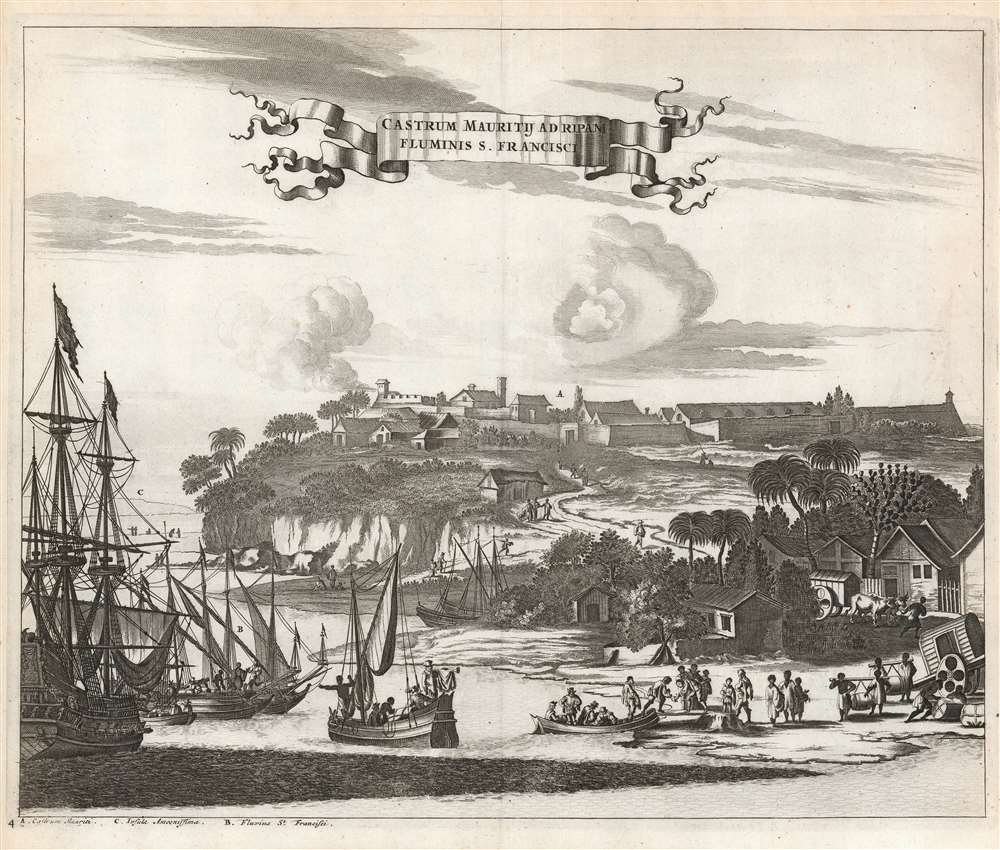1673 Montanus view of Fort Maurits, Brazil
FortMaurits-montanus-1673
Title
1673 (undated) 11.5 x 14 in (29.21 x 35.56 cm) 1 : 13850000
Description
Key Fort in the Sugar Trade
ort Maurits was established by the Dutch under the command of Johan Mauritz in 1637 as part of the West India Company's efforts to wrest the sugar-producing colony from the Portuguese. Following the capture of Pernambuco and Olinda by Hendrick Corneliszoon Loncq, the Dutch were calling their new possession Nieuw Holland - in spite of continued Portuguese resistance, leading to mutual scorched-earth campaigns which crippled sugar production for years. Dutch governance of the colony passed to Johan Maurits van Nassau-Siegen in 1637. Among his initial conquests that year was the destruction of the town of Penedo, 18 miles from the mouth of the São Francisco River. This he replaced with the fort that would bear his name - Fort Maurits - placed on the heights commanding the river.A Retrospective View
Mauritz brought with him an entourage of artists, including the painter Frans Post, who painted a panorama of this part of the São Francisco; Joan Blaeu would commit that image to print in 1647. The present view narrows the Post/Blaeu view to focus exclusively of the fort, and embellishes it with the lively shoreline trading scene visible here. The view reflects the period in the 1630s in which the Dutch maintained the upper hand in Brazil. But the 1640s saw a resurgence of Portuguese influence, and following the WIC's removal of Mauritz in 1644 the Dutch in Brazil collapsed under Portuguese offensives. After their surrender in January of 1654, the Dutch no longer held territory in Brazil; Montanus' 1671 view reflects a reality more than thirty years past.Publication History and Census
This view was engraved by Montanus for inclusion in John Ogilby's 1671 America and was used again by Montanus in 1673 for his Unbekannte Neue Welt in 1673. Thirteen examples of Montanus' book are catalogued by institutional collections. Seven separate examples of this view are listed in OCLC; they appear on the market from time to time.CartographerS
Arnoldus Montanus (c. 1625 - 1683) was a Dutch scholar, publisher, schoolmaster and author active in Amsterdam during the latter half of the 17th century. Montanus is a Latinized form of van den Berg or van Bergen. He studied theology at Leiden University and was ordained a minister in 1653. In 1667 he became headmaster of the Latin School of Schoonhoven, where he died in 1683. Most of Montanus's work was published in conjunction with engraver Jacob van Meurs and focused on travel narratives to Asia and the Americas. His most famous book, De Nieuwe en Onbekende Weereld, contains what is arguably the first view of New York City, the New Amsterdam. His other works offer up some of the earliest known descriptions of China and Japan. Much of Montanus' work was translated and published in English by John Ogilby. More by this mapmaker...
Joan (Johannes) Blaeu (September 23, 1596 - December 21, 1673) was a Dutch cartographer active in the 17th century. Joan was the son of Willem Janszoon Blaeu, founder of the Blaeu firm. Like his father Willem, Johannes was born in Alkmaar, North Holland. He studied Law, attaining a doctorate, before moving to Amsterdam to join the family mapmaking business. In 1633, Willem arranged for Johannes to take over Hessel Gerritsz's position as the official chartmaker of the Dutch East India Company, although little is known of his work for that organization, which was by contract and oath secretive. What is known is his work supplying the fabulously wealthy VOC with charts was exceedingly profitable. Where other cartographers often fell into financial ruin, the Blaeu firm thrived. It was most likely those profits that allowed the firm to publish the Theatrum Orbis Terrarum, sive, Atlas Novus, their most significant and best-known publication. When Willem Blaeu died in 1638, Johannes, along with his brother Cornelius Blaeu (1616 - 1648) took over the management of the Blaeu firm. In 1662, Joan and Cornelius produced a vastly expanded and updated work, the Atlas Maior, whose handful of editions ranged from 9 to an astonishing 12 volumes. Under the brothers' capable management, the firm continued to prosper until the 1672 Great Amsterdam Fire destroyed their offices and most of their printing plates. Johannes Blaeu, witnessing the destruction of his life's work, died in despondence the following year. He is buried in the Dutch Reformist cemetery of Westerkerk. Johannes Blaeu was survived by his son, also Johannes but commonly called Joan II, who inherited the family's VOC contract, for whom he compiled maps until 1712. Learn More...
Frans Janszoon Post (November 17, 1612 - February 17, 1680) was a Dutch Golden Age painter, and the first European artist to paint landscapes of the Americas. Of his approximately 140 known paintings, most are landscapes depicting specific locations in Brazil. He was the son of a Leiden glass painter, and the brother of a key Dutch architect. Although his initial training was likely at the hands of his father and brother, it is not known which master under which he studied and he did not join a guild until his return from Brazil. Possibly through his brother's influence, he was commissioned by Maurice, Prince of Nassau-Siegen to travel to Brazil, where he would live and work from 1637 to 1644. He would continue to paint Brazilian scenes long after his return; but his output declined sharply ten years prior to his death, possibly due to an alcohol problem. Images from his views found their way into printed maps and panoramas of Brazilian scenes, such as those produced by Joan Blaeu and Arnold Montanus. Learn More...

